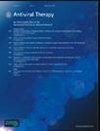新型环氧合酶2抑制剂对人巨细胞病毒体外复制的影响
IF 2.3
4区 医学
Q4 INFECTIOUS DISEASES
引用次数: 4
摘要
背景人巨细胞病毒(HCMV)与免疫功能低下患者的并发症有关。目前的治疗方法有几个缺点,例如肾毒性。目的:由于HCMV感染影响炎症途径,特别是通过环氧合酶2(COX-2)产生前列腺素E2(PGE2),我们设计了2'-羟基查尔酮化合物来抑制人巨细胞病毒。研究设计我们首先选择了最有效的新合成查尔酮,以对抗COX-2催化的PGE2。研究样本在选定的化合物中,我们评估了对不同HCMV菌株的抗病毒效果,如实验室菌株AD169和临床菌株(对常规药物具有幼稚或多重耐药性),以及对人体细胞的毒性。结果用Compusyn软件检测了最有效、毒性最小的化合物查尔酮7与其他抗病毒分子青蒿琥酯(ART)、黄芩苷(BAI)、马里巴韦(MBV)、更昔洛韦(GCV)和槲皮素(QUER)联合对抗HCMV。查尔酮7与MBV和BAI具有协同作用,与QUER具有拮抗作用,与GCV和ART具有加性作用。本文章由计算机程序翻译,如有差异,请以英文原文为准。
Impact of new cyclooxygenase 2 inhibitors on human cytomegalovirus replication in vitro
Background Human cytomegalovirus (HCMV) is involved in complications on immunocompromised patients. Current therapeutics are associated with several drawbacks, such as nephrotoxicity. Purpose: As HCMV infection affects inflammation pathways, especially prostaglandin E2 (PGE2) production via cyclooxygenase 2 enzyme (COX-2), we designed 2'-hydroxychalcone compounds to inhibit human cytomegalovirus. Study design We first selected the most efficient new synthetic chalcones for their effect against COX-2-catalyzed PGE2. Study sample Among the selected compounds, we assessed the antiviral efficacy against different HCMV strains, such as the laboratory strain AD169 and clinical strains (naïve or multi-resistant to conventional drugs) and toxicity on human cells. Results The most efficient and less toxic compound (chalcone 7) was tested against HCMV in combination with other antiviral molecules: artesunate (ART), baicalein (BAI), maribavir (MBV), ganciclovir (GCV), and quercetin (QUER) using Compusyn software. Association of chalcone 7 with MBV and BAI is synergistic, antagonistic with QUER, and additive with GCV and ART. Conclusion These results provide a promising search path for potential bitherapies against HCMV.
求助全文
通过发布文献求助,成功后即可免费获取论文全文。
去求助
来源期刊

Antiviral Therapy
医学-病毒学
CiteScore
2.60
自引率
8.30%
发文量
35
审稿时长
4-8 weeks
期刊介绍:
Antiviral Therapy (an official publication of the International Society of Antiviral Research) is an international, peer-reviewed journal devoted to publishing articles on the clinical development and use of antiviral agents and vaccines, and the treatment of all viral diseases. Antiviral Therapy is one of the leading journals in virology and infectious diseases.
The journal is comprehensive, and publishes articles concerning all clinical aspects of antiviral therapy. It features editorials, original research papers, specially commissioned review articles, letters and book reviews. The journal is aimed at physicians and specialists interested in clinical and basic research.
 求助内容:
求助内容: 应助结果提醒方式:
应助结果提醒方式:


